 Serious social media governance leaders know that a crisis event is in their future. A social media crisis is not an "if" but a "when" situation. So the real question is: are you and your corporation ready to take charge and mitigate the risks when it happens? Recently, the NFL was put to the test when the hacker group OurMine decided to wreak havoc with team and player social media accounts. It's a good time to think about that event and ask yourself if you and your corporation are prepared to manage a social media crisis event like the NFL accounts being hijacked by hackers?
Serious social media governance leaders know that a crisis event is in their future. A social media crisis is not an "if" but a "when" situation. So the real question is: are you and your corporation ready to take charge and mitigate the risks when it happens? Recently, the NFL was put to the test when the hacker group OurMine decided to wreak havoc with team and player social media accounts. It's a good time to think about that event and ask yourself if you and your corporation are prepared to manage a social media crisis event like the NFL accounts being hijacked by hackers?
How to Prepare for a Social Media Crisis Event
Every company should be able to answer these questions:
- When a social media crisis strikes, are we prepared to react quickly?
- What will we need to do first, second, etc?
- Who has to be involved?
- What is the process of recovery to get back to stasis?
- a global or diverse footprint
- a chain of retail properties
- a large number of brands
That means you probably have a lot of social media channels or what we call points-of-presence. For example, you are likely to have a different Twitter account for each brand in each country, region, or language you serve. Alternatively, if you're a retail brand, you probably have a different Facebook page for every retail outlet (e.g. store, hotel, restaurant, etc). It’s not unusual for an enterprise to have an extremely large number of such social media properties (i.e. points-of-presence or POPs).
Let's look at an enterprise with just 6 brands sold around the world. Our experience is that every brand has about 3-5 points-of-presence in every locality it is represented (e.g. a Twitter account, a Facebook Page, a Pinterest and/or Instagram account, and a Youtube channel). The actual platforms vary based on country and culture but 4 is a good working number. As for countries, there are over 195; so, let’s say each brand is represented in 60% of them or 117 countries. This equates to:
6 brands X 4 POPs per brand X 117 countries = 2,808 POPs
Now let’s consider an enterprise with 3 retail brands represented in 200 cities, again with 4 POPs per location.
3 brands X 4 POPs per location X 200 locations = 2,400 POPs
We actually have customers who manage more social media channels than that in the Brandle Presence Manager. These examples show how easy it is for the number of properties your enterprise has to maintain (and govern) can easily count in the hundreds if not thousands. Even at half those numbers, we're talking a significant job for any team.
Now, let’s consider two scenarios that have happened recently: a) a platform detects a security risk and invalidates all the access tokens you’ve granted to your workflow, publishing, listening, and customer care applications; or b) one of the tools you use for workflow, publishing, listening, or customer care detects a security risk and invalidates all access tokens to all platforms supported by that tool. Now you need to go through the very labor intensive process of re-authenticating each point-of-presence on each platform for each tool. This can take hours and often days to complete.
Not only is such a process a huge effort but it is likely it is going to require the actions of people spread throughout your enterprise plus several outside agencies who help you manage certain channels, brands, or regions. The average large enterprise has 500-600 contacts identified in the Brandle Presence Manager to track all the people associated with their POPs. Now you need to know who to contact to re-authenticate all these channels to the various tools used to maintain them.
You may need to coordinate the actions of dozens of people based on their relationship to a particular set of accounts (e.g. by country or region, division, brand, third-party, etc). How are you going to do that? How are you going to know who to contact for which property?
This is where a governance platform like the Brandle Presence Manager can save you a significant amount of time, as one of our customers recently reported it did for her enterprise (in a very nice "Thank you" note). By having a complete inventory of every place the enterprise is represented across the web and around the world, an enterprise can quickly answer questions like:
- What accounts represent brand X?
- What accounts do we have on platform Y?
- Which accounts do we have connected to tool Z?
- Which agencies are managing these properties or which properties are managed by Agency A?
So, when a crisis strikes, you can now get a quick answer to “Who are the Principal Contacts for the POPs representing Brand X on platform Y, which are connected to tool Z and managed by agency A?” Now you know who to contact and how…and you can track the status of getting everything back into working order. You don't want to try to do this with a spreadsheet.
Governing your enterprise’s footprint and those managing it across all your target markets, platforms, and tools is a big job. You didn’t build this infrastructure over night and it is a massive effort to make sweeping updates or changes…and that does not include the day to day challenges of a managing so many properties, people, platforms, tools, agencies, and ad accounts in a constantly changing environment.
This is why a governance platform, like the Brandle Presence Manager, which tracks and monitors all those properties, people, platforms, tools, agencies, and ad accounts is vital to any organization of decent size.
Don’t wait until the next crisis strikes to figure out how you’re going to react. Prepare today and save yourself the pain and suffering that will come. To read more about social media security risks, check out this blog post.
To learn more about Brandle, just ask us for a demo — we're happy to show you how easy it is to manage your global digital footprint!








